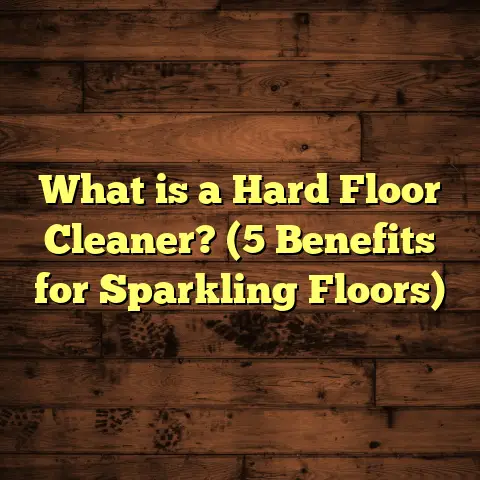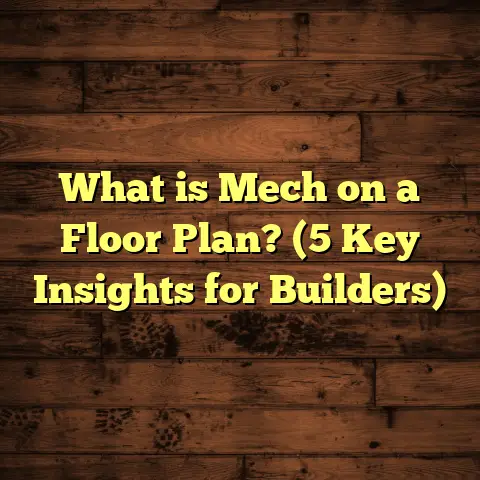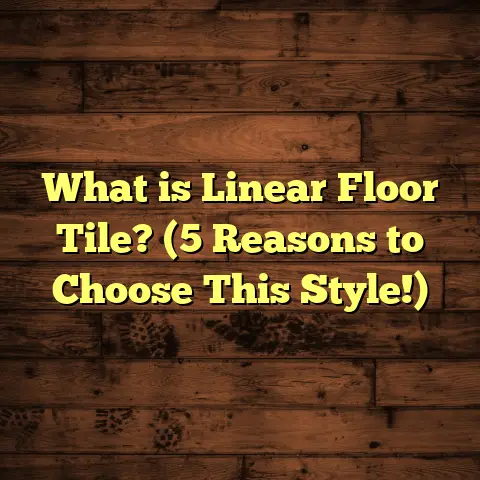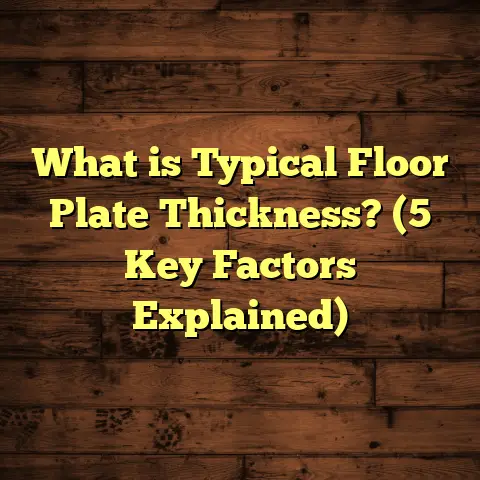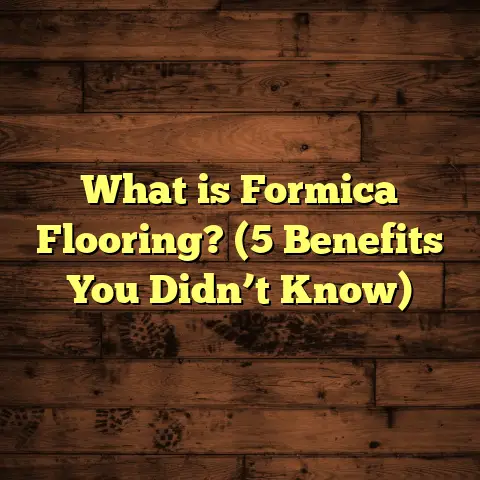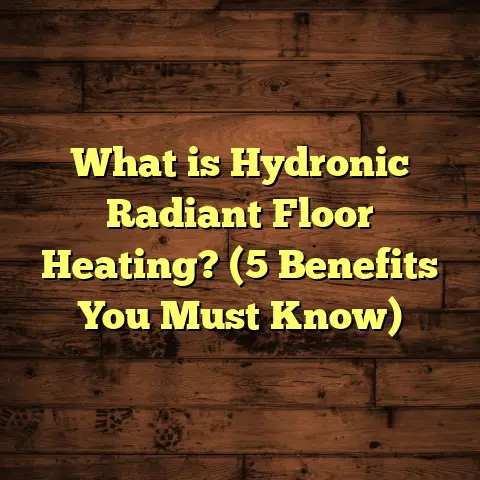What is LVR Flooring? (5 Key Benefits You Need to Know)
When I first encountered LVR flooring in my early years as a flooring contractor, I was immediately intrigued by what it offered. It seemed to bring together the best features of various flooring materials into one product — durability, visual appeal, and ease of installation. Over the years, I’ve installed LVR floors for all kinds of clients: busy families, commercial businesses, even boutique hotels. What struck me most is how this product can fit so many needs and styles without breaking the bank. If you’re curious about what makes LVR flooring stand out and whether it could be right for your home or project, let me walk you through everything I’ve learned.
What is LVR Flooring?
LVR stands for Luxury Vinyl Rigid flooring. To put it simply: it’s a type of luxury vinyl flooring built on a solid, rigid core instead of a flexible one like traditional vinyl planks or sheets. This core is what gives LVR its unique strength and stability.
If you’ve ever laid down vinyl flooring before, you might know that older styles can feel thin or flimsy, almost like a vinyl sheet that moves underfoot. LVR changed that by introducing a tougher base layer that keeps the floor steady and resistant to dents or warping.
The Science Behind LVR’s Structure
The rigid core can be made from materials like Stone Plastic Composite (SPC) or Wood Plastic Composite (WPC). Both have their advantages:
- SPC (Stone Plastic Composite): This uses limestone powder mixed with PVC to create an incredibly dense and hard core. It’s more durable and waterproof.
- WPC (Wood Plastic Composite): Combines wood fibers with plastic to create a slightly softer but more cushioned core. It’s warmer underfoot but less dense than SPC.
On top of this sturdy core is the high-definition printed vinyl layer that mimics natural materials such as wood grain, stone, or ceramic tile. This print is protected by a clear wear layer that resists scratches, stains, and scuffs.
Finally, the backing layer adds moisture protection and sometimes sound absorption.
This multi-layer construction is why LVR can deliver on looks and performance in ways traditional vinyl or laminate often can’t.
Why the “Luxury” in Luxury Vinyl Rigid?
The word “luxury” might make you think this flooring is expensive or out of reach for typical homeowners. But here’s where LVR surprises many: it offers very realistic appearance features often reserved for pricier materials like hardwood or natural stone — but at a fraction of the cost.
The texture on the surface isn’t just a flat print. It’s embossed with depth and detail that you can actually feel when you run your hand across the plank. That texture adds authenticity and makes the floor look genuinely natural, not plastic-y.
Five Key Benefits of LVR Flooring You Should Know
Over my many installations and consultations, I’ve seen firsthand what makes LVR a go-to choice for so many people. Here are five major benefits that stand out:
1. Durability That Withstands Everyday Life
One thing I always ask clients about is how much traffic their floors will take. Are there kids? Pets? Heavy furniture? Lots of foot traffic?
LVR shines in these situations because its rigid core resists dents, scratches, and impacts far better than traditional vinyl or laminate.
I remember working with a family whose two young boys loved playing soccer indoors — something you wouldn’t want on delicate hardwood floors! Their LVR held up perfectly through months of rough play.
A 2023 report by Floor Covering Weekly found SPC-based LVR floors offer up to 35% higher impact resistance than regular luxury vinyl planks.
That durability doesn’t just protect your investment — it also means less maintenance headaches over time.
2. Near-Complete Water Resistance
One of the biggest problems with hardwood or laminate flooring is water damage. Even small spills or humidity can cause swelling, warping, or mold growth under the floor.
LVR’s rigid core construction makes it almost fully waterproof — especially SPC variants.
I’ve installed LVR in kitchens, bathrooms, basements — places where water exposure is a risk — and never had an issue with warping or staining.
In fact, SPC cores have a zero water absorption rate according to manufacturers’ technical data sheets. That means water can’t seep into the core and cause damage.
For example: I installed LVR flooring in a laundry room for a client who often dealt with leaking washing machines. The floor stayed flawless after two years despite several incidents.
3. Realistic Looks Without Breaking the Bank
You might wonder if vinyl can truly mimic hardwood or stone well enough to satisfy design-conscious homeowners.
Based on my experience and recent surveys, the answer is yes.
A 2024 Home Flooring Trends Survey showed nearly 80% of homeowners who installed LVR were impressed by how closely it resembled natural materials.
That comes down to advances in printing technology and embossing techniques that create realistic textures and color variations.
One client wanted an elegant oak floor look but couldn’t afford real hardwood’s cost and maintenance. LVR gave them the exact visual effect they wanted for about 40% less money.
4. Faster, Easier Installation
As a flooring contractor, I appreciate anything that speeds up installation without sacrificing quality. That’s exactly what happens with LVR.
Most LVR products use a click-lock system that allows planks to snap together without glue or nails.
That means quicker installs — sometimes cutting labor time in half compared to glue-down vinyl or traditional hardwood nail-down systems.
For DIYers, this is a huge bonus since it reduces complexity and tools needed.
I guided a couple through their first-ever flooring install using LVR planks last year. They finished the entire living room in two days with no issues.
5. Comfort & Noise Reduction
Some floors feel hard and cold underfoot — especially tiles or laminate over concrete slabs.
LVR often incorporates a cushioned core layer or backing that adds softness when walking or standing for long periods.
This helps reduce foot fatigue in kitchens or areas where people spend lots of time on their feet.
Plus, the backing helps absorb sound, making rooms quieter by minimizing echo and footsteps noise.
In an office project I worked on last year, installing LVR noticeably improved acoustics — employees said it felt more comfortable and less noisy than before.
Diving Deeper: My Personal Stories With LVR Flooring
I want to share some detailed examples from my projects to give you an idea of how versatile and reliable LVR can be.
The Busy Family Basement Transformation
A few years ago, I helped a family convert their damp basement into a cozy entertainment room. They wanted real wood flooring but were worried about moisture damage.
After showing them SPC-based LVR options, they went for a dark walnut finish that looked stunning. Installation took just three days despite minor subfloor leveling required.
Six months later, they told me the floor looked perfect — no warping or discoloration despite some flooding during heavy rains nearby.
The total cost was about $7 per square foot installed, while engineered hardwood would have been closer to $15 per square foot in their area.
Boutique Hotel Lobby Renovation
Another memorable job was with a boutique hotel owner who wanted to upgrade their lobby floors quickly but attractively.
We chose WPC-based LVR planks with a light oak finish for warmth and comfort underfoot. The fast click-lock installation allowed us to finish before grand reopening day with minimal disruption.
Guests complimented the new floors for their look and quiet feel compared to noisy tiles previously installed.
This project showed me how practical LVR can be for commercial spaces balancing style with function.
Tips & Tricks From My Experience
If you decide to go with LVR flooring, here are some tips I’ve picked up over years of installing and advising customers:
Core Choice Matters
- SPC: Denser, harder, best for high traffic or moisture-prone areas.
- WPC: Softer, warmer feel but slightly less impact resistant. Think about your specific space requirements before choosing.
Thickness Counts
LVR planks typically range between 4mm and 8mm thickness. Thicker options provide better durability and help hide uneven subfloors. For unfinished basements or older homes with imperfections in flooring level, thicker planks are worth considering.
Prep Your Subfloor Well
Even though LVR is forgiving compared to hardwood, a clean, level subfloor makes installation smoother. Use leveling compounds if necessary. Proper prep helps prevent squeaks or uneven wear later on.
Underlayment Helps
Some LVR comes with attached underlayment. If yours doesn’t, add a separate compatible underlay for sound reduction and comfort. Make sure it’s recommended for use with your specific product type to avoid warranty issues.
Maintain Regularly But Gently
Sweep or vacuum frequently to remove dirt and grit that could scratch surfaces. Use mild cleaners designed for vinyl floors. Avoid abrasive scrubbers or harsh chemicals that could wear down protective layers over time.
Interesting Stats & Data You Might Like
- Durability: SPC LVR impact resistance rating is up to 35% higher than traditional luxury vinyl (Floor Covering Weekly, 2023).
- Waterproof: SPC cores have zero water absorption rate (Manufacturer Technical Data).
- Cost: Installed LVR ranges from $5-$10 per square foot versus hardwood’s typical $8-$15+ (National Flooring Association).
- Customer Satisfaction: Nearly 80% rate LVR as visually comparable to natural wood/stone (Home Flooring Trends Survey).
- Installation Time: Click-lock systems reduce installation time by up to 50% compared to glue-down vinyl (Industry Report 2023).
Comparing LVR With Other Flooring Types: What Makes It Different?
Sometimes clients ask me how LVR stacks up against other popular flooring options like laminate, hardwood, or traditional vinyl. Here’s how I break it down:
| Flooring Type | Durability | Water Resistance | Cost per sq ft | Installation Complexity | Appearance Realism |
|---|---|---|---|---|---|
| Hardwood | Medium – Can dent | Low – Susceptible | $8 – $15+ | High – Nails/glue | High – Real wood |
| Laminate | Medium – Scratches | Low – Swells if wet | $3 – $8 | Medium – Click-lock | Medium – Printed surface |
| Traditional Vinyl | Medium – Flexible | High – Waterproof | $2 – $7 | Low – Glue/Click | Medium – Printed surface |
| LVR (SPC / WPC) | High – Rigid Core | Very High – Waterproof | $5 – $10 | Low – Click-lock | High – Textured/Realistic |
What stands out here is how well-rounded LVR is: combining toughness with water resistance while still looking natural — all at reasonable cost and easy installability.
What Are Some Common Questions About LVR Flooring?
Q: Can I install LVR over existing floors?
A: Often yes! As long as your current floor is flat and stable (like concrete or plywood), you can usually install LVR right over it without removing old flooring first.
Q: How long does LVR last?
A: With proper care, good-quality LVR can last 15-20 years or more. Many manufacturers offer warranties between 10-25 years depending on product grade.
Q: Is LVR eco-friendly?
A: Vinyl products have environmental concerns due to PVC content but some manufacturers now offer recycled content options or low-VOC certifications for better indoor air quality.
Q: Can I use LVR in commercial spaces?
A: Absolutely! SPC-based rigid core vinyl is popular in retail stores, offices, hotels because of durability and ease of maintenance.
My Final Take After Years of Working With LVR
LVR flooring has become one of my favorite materials to recommend because it hits so many marks:
- It looks great with realistic textures
- It’s tough enough for active households
- It handles moisture better than most floors
- It installs quickly saving time & money
- It feels comfortable underfoot & absorbs sound
If you want beautiful floors without high maintenance headaches or high costs — chances are good that LVR fits your needs perfectly.
Have you considered trying out LVR in your home? Or maybe you’ve already taken the plunge? I’d love to hear about your experience or help answer any questions you might have about picking or installing these floors!
